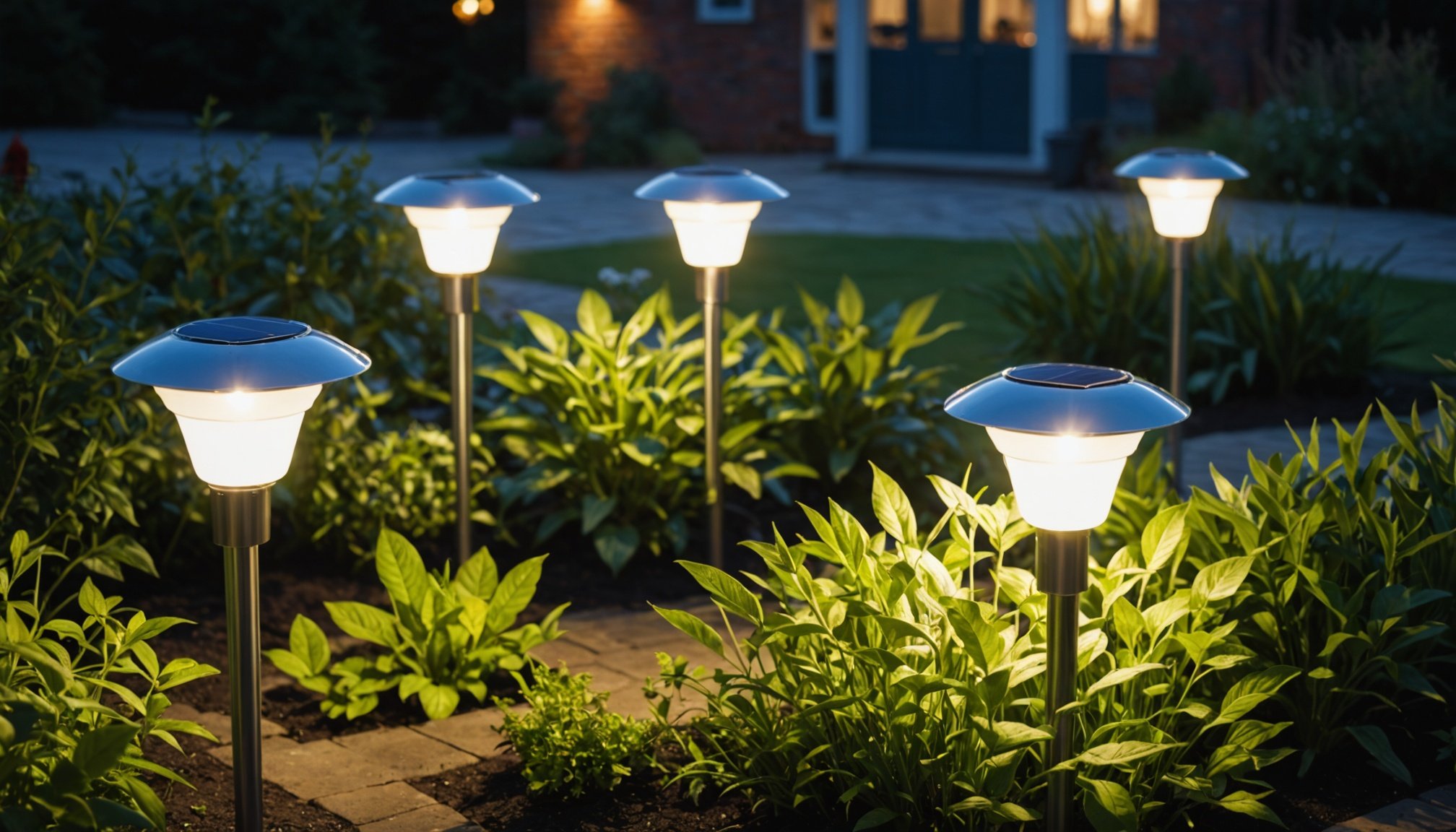In the realm of sustainable solutions for the home, solar lights are emerging as a stylish, practical, and eco-friendly addition. They can transform your outdoor living spaces, providing an alluring ambient glow and enhancing the aesthetic appeal of your garden. Solar lighting harnesses the power of the sun, saving on your energy bills and reducing your carbon footprint. So, how can you integrate solar lighting into your UK garden for sustainability? Let’s dive in and explore.
Choosing the Best Solar Lights for Your Garden
Before you embark on your solar lighting journey, it’s crucial to find the best solar light design to fit your needs and the feel of your garden. Whether you want to create a dramatic effect or simply light your way in the dark, you’ve got a myriad of options.
A découvrir également : Transform Your Compact UK Flat: The Ultimate Guide to Vertical Gardening for Space Optimization
Pathway lights are a common choice for solar light installations. These low-to-the-ground lights are often installed along walkways or driveways. They add safety and beauty to your outdoor space. Decorative lights, on the other hand, come in various shapes, colours, and designs. They are often used to enhance garden features or create a warm, welcoming atmosphere.
Solar spotlights and task lights are the brightest class of solar lights and can be used to highlight specific features of your garden. These are an ideal choice for your UK garden, as they can provide the most light for the smallest amount of energy consumption.
En parallèle : Enhance Your Outdoor Space with Durable Shade Sails
Remember, the best solar lights will have a high lumen count (brightness), a long lifespan, and a good degree of waterproofing, particularly important in the UK’s rainy climate.
Understanding Solar Panels and Energy Storage
The heart of any solar-powered light is the solar panel and energy storage system. Understanding these elements will help you make an informed decision about your solar lighting installation.
Solar panels convert sunlight into electricity. They are usually made up of many small solar cells, which are made of a semiconductive material, usually silicon. When the sun’s light hits the cells, it causes electrons to move, thus producing electric current.
For your solar garden lights to function after sunset, they need to store energy. This is where batteries come in. The solar panel charges the battery during the day, which then powers the light during the night. Look for solar lights with lithium-ion batteries as they have a higher energy density, longer lifespan and better performance in cold weather.
It’s worth noting that the location of your lights can impact their performance. The solar panels should ideally be positioned to receive direct sunlight for the most effective charge.
Designing Your Garden with Solar Lights
The design of your solar lighting can dramatically affect the mood and functionality of your outdoor space. Consider the areas you want to illuminate and the purpose of the light.
Do you want to illuminate a pathway to the front door, or highlight a garden feature? The positioning of your lights will depend on this. Ground-level lights are great for pathways, while spotlights can be positioned higher up to accentuate features.
A well-lit garden can appear larger and more inviting. Use lights to draw attention to your favourite areas and to guide your guests through your garden. Solar lights can also provide security by illuminating darker areas that might be inviting for intruders.
Installation of Solar Lights
Now that you’ve chosen your lights and planned your design, it’s time for the installation process. The great thing about solar lights is that they are incredibly easy to install. Most simply need to be staked into the ground.
For solar spotlights, you might need to secure them to a solid surface like a wall, fence or ground using screws, but usually, no wiring is required. Remember to position the solar panel where it can receive the most sunlight.
Once installed, you need to turn on the switch, usually located at the back or bottom of the solar light, and the built-in sensor will take care of the rest. It turns the lights on at dusk and off at dawn, providing your garden with an automated lighting solution.
Remember to clean the solar panels regularly. Dirt and dust can reduce their efficiency in converting sunlight into power.
Post-installation Care and Maintenance
Once you’ve installed your solar lights, they will need some level of upkeep to remain effective and efficient. Regular cleaning is a must – dirt, dust, and debris can accumulate on the solar panel, diminishing its ability to generate power.
During periods of dull weather – hardly uncommon in the UK – take care to ensure that your lights are receiving enough light. It can be worth temporarily moving them into direct sunlight to receive a full charge.
Also, keep an eye on the battery. Most will last between one to three years before needing a replacement. Remember that regular charging and discharging of the battery can extend its lifespan.
Solar lights are a brilliant way to bring charm and cheer to your garden while embracing sustainable living. By implementing these tips, you will be able to transform your outdoor space into an enchanting, eco-friendly haven.
Choosing the Ideal Location for Solar Lights
Picking the perfect location for your solar lights plays a pivotal role in maximising their efficiency and contribution towards sustainability. Remember that solar panels rely on sunlight to generate electricity, so choosing an area with sufficient sunlight exposure is key.
For those living in the UK, the sun tends to be at its brightest in the south. Therefore, try to position your solar lights in a south-facing direction. If your garden has trees or buildings that cast shadows, ensure your solar lights are placed away from these obstructions.
Pathway lights should be installed along driveways and walkways to safely guide the way after dark. Decorative lights can be placed in flower beds or near garden features to accentuate their beauty. Solar spotlights and task lights can be mounted higher up to illuminate specific areas or features of your garden.
Remember to correctly tilt your solar panels. In the UK, an ideal tilt angle would be around 35-40 degrees to capture the most sunlight. Most importantly, the solar panel that comes with your solar light should be directly exposed to the sun without any cover or shade.
Choosing Between Ground Mounted and Wall Mounted Solar Lights
Choosing between ground-mounted and wall-mounted solar lights largely depends on the function and design of your garden. Both types have their unique advantages and can make a significant impact on your garden’s ambience and sustainability.
Ground mounted solar lights are typically used to create a beautiful lighting effect on the ground. They’re perfect for illuminating pathways, highlighting garden features or creating a border around a specific area. Ground mounted lights are usually easy to install and can be moved around to suit your garden’s design changes.
On the other hand, wall mounted solar lights provide a higher light source, making them ideal for security purposes or illuminating a larger area. They can be installed on walls, fences or posts and are particularly effective for directional lighting, such as spotlighting a garden feature.
Whether you prefer ground-mounted or wall-mounted solar lights, both options are an excellent way to enhance your garden and contribute to energy conservation.
Conclusion
Embracing solar lighting in your UK garden is more than just a stylish trend; it’s a conscious step towards sustainable living. Solar lights are a versatile, eco-friendly solution that can completely transform the look and feel of your outdoor space.
By choosing the right type and design of solar lights, understanding the workings of solar panels and energy storage, and properly planning the installation and positioning, you can effectively integrate solar lighting into your garden.
Keep in mind the maintenance needs of your solar lights to ensure they remain efficient and functional. The UK weather may pose some challenges, but with the right care, your solar garden lights can provide a beautiful and sustainable lighting solution for years to come.
Not only will you be enhancing the beauty of your garden, but you’ll also be reducing your energy consumption and carbon footprint. So, make the switch to solar and let your garden be a beacon of sustainability.











